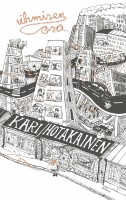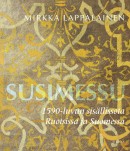Search results for "2010/02/2011/04/2009/10/writing-and-power"
Anu Lahtinen: Pohjolan prinsessat. Viikinkineidoista renessanssiruhtinattariin [Princesses of Pohjola. From Viking maidens to Renaissance princesses]
22 February 2010 | Mini reviews, Reviews
 Pohjolan prinsessat. Viikinkineidoista renessanssiruhtinattariin
Pohjolan prinsessat. Viikinkineidoista renessanssiruhtinattariin
[Princesses of Pohjola. From Viking maidens to Renaissance princesses]
Jyväskylä: Atena, 2009. 223 p., ill.
ISBN 978-951-796-595-8
€ 33, hardback
This book, a side project to Anu Lahtinen’s doctoral dissertation, tells of the women of the Nordic royal families from the 7th to the 17th centuries. The term ‘princesses’ is used here to refer to female members of ruling families who did not hold positions of power themselves. With its brief biographies of people who have long remained hidden in the historical shadow of great men, this book sheds light on a little-researched subject. Many princesses of the medieval Swedish, Danish and Norwegian realms grew up into significant political figures; they needed cunning, a good command of languages and even fighting skills in order to survive the tumults of that age. The rollicking parties and romantic escapades of Cecilia, one of the five daughters of King Gustav Vasa of Sweden, are reminiscent of the ‘party princesses’ of our own time. A Viking-era princess, Alfhild, became a pirate captain; according to medieval tales, she disguised herself as a man and managed to lead a crew of female pirates in a number of raids along the shores of the Baltic.
Living inside language
23 February 2010 | Essays, Non-fiction
Jyrki Kiiskinen sets out on a journey through seven collections of poetry that appeared in 2009. Exploring history, verbal imagery and the limits of language, these poems speak – ironically or in earnest – about landscapes, love and metamorphoses
The landscape of words is in constant motion, like a runner speeding through a sweep of countryside or an eye scaling the hills of Andalucia.
The proportions of the panorama start to shift so that sharp-edged leaves suddenly form small lakeside scenes; a harbour dissolves into a sheet of white paper or another era entirely. Holes and different layers of events begin to appear in the poems. Within each image, another image is already taking shape; sensory experiences develop into concepts, and the text progresses in a series of metamorphoses. More…
Anu-Hanna Anttila & al.: Kuriton kansa [Unruly nation]
13 August 2010 | Mini reviews, Reviews
 Anu-Hanna Anttila & Ralf Kauranen & Olli Löytty & Pollari Mikko Rantanen Pekka & Petri Ruuska
Anu-Hanna Anttila & Ralf Kauranen & Olli Löytty & Pollari Mikko Rantanen Pekka & Petri Ruuska
Kuriton kansa. Poliittinen mielikuvitus vuoden 1905 suurlakon ajan Suomessa
[Unruly nation. The political imagination of the 1905 general strike in Finland]
Tampere: Vastapaino, 2009. 317 p., ill.
ISBN 978-951-768-246-6
€ 33, paperback
In the beginning of the 20th century the Grand Duchy of Finland, a part of the Russian Empire, entered a period of crisis and began to turn into a nation with its own institutions. Universal and equal suffrage increased tenfold the number of those eligible to vote. A move to the granting of political rights was demanded during the 1905 general strike, which was both an internal political power struggle and a demonstration by Finns against the Russification measures being imposed by their rulers. The book examines the ideological currents of the strike period and investigates their definitions of ‘nation’ and ‘nationality’, with reference to literary research, historical sociology, cultural studies and women’s studies, making extensive use of contemporary documents. The book’s essays portray the spectrum of ideas, reflected in groups like the theosophists, Tolstoyans and anarchists.
What God said
3 September 2009 | Fiction, Prose
Extracts from the novel Herra Darwinin puutarhuri (Otava, 2009; Mr Darwin’s Gardener, Peirene Press, 2013). Interview by Soila Lehtonen
The congregation sits in the church pews and the jackdaws caw in the belfry.
We smell of wet dog, the rain made us wet and it is cold but the singing warms us, the hymn rises to the roof and above the roof dwells God, Amen.
We saw Thomas Davies on the hill, he is working in Mr Darwin’s garden,
the atheist and lunatic, he stood in the field alone and the water lashed his face
an irreligious pit pony wandering in the darkness he is from Wales
does the godless man think he can stand in the rain without getting wet did he get an umbrella or bat wings from the devil
perhaps Thomas imagines that he can hold back the rain and the rain not hold him back, he thinks he is more exalted than God with his head in the clouds
The church’s hard pews press into posteriors, the poor man will not grow fatter, for there are no fat and lean years but only lean ones, and thin are the poor man’s sheep and cows and children too, but the rich man cultivates weeds for his amusement as Mr Darwin did and earns money and fame! More…
Maria Turtschaninoff: Arra. Legender från Lavora [Arra. Legends from Lavora]
12 February 2010 | Mini reviews, Reviews
 Arra. Legender från Lavora
Arra. Legender från Lavora
[Arra. Legends from Lavora]
Helsinki: Söderströms, 2009. 251 p.
ISBN 978-951-52-2604-4
19.90 €, hardback
Legender från Lavora by Maria Turtschaninoff (born 1977) is limpid and leisurely in tone, yet the story of Arra, a girl from a poor family, is intense, tragic and original. Because she is mute, Arra is thought to be feeble-minded, and thus of no value to her family. She becomes, in fact, an ‘invisible child’ – the author’s reference to neglected children of the present day. The girl uses a special power to compensate for the contempt of those around her: she binds herself in living connection with nature, which leads her in the end to glory and honour. Because of Arra’s long period of muteness as she enters her teens, dialogue is a very small portion of the book. The narrative may be challenging for young readers, but the vivid love story of Arra and Prince Surando has an irresistible, magical enchantment.
Kari Hotakainen: Ihmisen osa [The human lot]
9 October 2009 | Mini reviews, Reviews
 Ihmisen osa
Ihmisen osa
[The human lot]
Helsinki: Siltala, 2009. 276 p.
ISBN 978-952-234-021-4
30 €, hardback
Kari Hotakainen (born 1957) is one of Finland’s most internationally successful contemporary authors, and is widely known for his children’s books, plays and television screenplays. Like many of Hotakainen’s other works, Ihmisen osa is a contemporary novel, but it is one that sees the author being angrier and more ferocious than before; this is a story that will move readers and make them laugh. Its plot gets off to a slightly ungainly start: an impatient writer wants to ‘buy someone’s life’ for the purpose of turning it into material for a novel and is prepared to pay an elderly widow €7,000 for hers. A former yarn-seller tells him all about her life as she remembers it, and the writer writes it up into his own book – the husband’s wilful silence, a serious accident suffered by one of the three children, gradually being revealed. Having got the beginning out of the way, Hotakainen then puts his foot on the gas: in his laconic style he throws light on the conditions at the edges of contemporary working life: the business of selling images, selfishness and greed, the power of words. The yarn-seller writes to one of her children: ‘Don’t rise above your station. There’s no air up there, and you’ll get dizzy.’ Hotakainen’s novel Juoksuhaudantie (‘Trench Road’) was awarded the Finlandia Prize for Fiction in 2002. It has been translated into 17 languages and was awarded the Nordic Council’s Literature Prize in 2004.
Mirkka Lappalainen: Susimessu – 1590-luvun sisällissota Ruotsissa ja Suomessa [Wolf Mass. Civil war in Sweden and Finland in the 1590s]
4 June 2010 | Mini reviews
 Susimessu – 1590-luvun sisällissota Ruotsissa ja Suomessa
Susimessu – 1590-luvun sisällissota Ruotsissa ja Suomessa
[Wolf Mass. Civil war in Sweden and Finland in the 1590s]
Helsinki: Siltala, 2009. 319 p.
ISBN 978-952-234-016-0
€32, hardback
Sweden at the end of the 16th century was riven by struggles for power: the opponents were the Protestant Duke Charles and Sigismund, King of Poland and Sweden, a strong supporter of the Counter-Reformation in the Nordic lands. A peasant uprising that came to be known as the ‘Cudgel War’ was underway in Finland – then part of the kingdom of Sweden. This book recounts the dramatic history of that civil war and, in line with current interpretive methods of historical research, explodes some popular myths that have been built up around these events. Mirkka Lappalainen has gained recognition as a bold writer who skilfully combines micro- and macro-level history. She characterises Sigismund, whom the Vatican supported to no avail, as a ‘melancholy, absent-minded vacillator, who preferred to play music.’ Lappalainen provides a fascinating alternative historical interpretation of what would have happened if the Vatican’s plans to wrest Finland away from Sweden and unite it with Poland had come to fruition.
Paris match
30 June 2011 | Articles, Non-fiction
In 1889 the author and journalist Juhani Aho (1861–1921) went to Paris on a Finnish government writing bursary. In the cafés and in his apartment near Montmartre he began a novella, Yksin (‘Alone’), the showpiece for his study year. Jyrki Nummi introduces this classic text and takes a look at the international career of a writer from the far north

Juhani Aho. Photo: SKS/Literary archives
Yksin is the tale of a fashionable, no-longer-young ‘decadent’, alienated from his bourgeois circle, and with his aesthetic stances and social duties in crisis. He flees from his disappointments and heartbreaks to Paris, the foremost metropolis at the end of the 19th century, where solitude could be experienced in the modern manner – among crowds of people. Yksin is the first portrayal of modern city life in the newly emerging Finnish prose, unique in its time.
Aho’s story has parallels in the contemporary European literature: Karl-Joris Huysmans’s A Rebours (1884), Knut Hamsun’s Hunger (1890) and Oscar Wilde’s The Portrait of Dorian Gray (1890). More…



